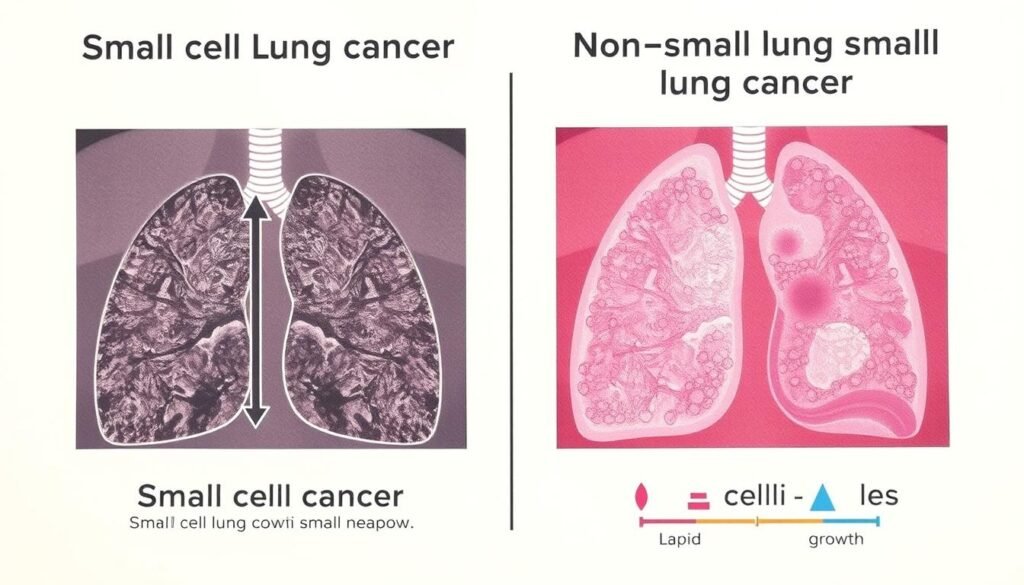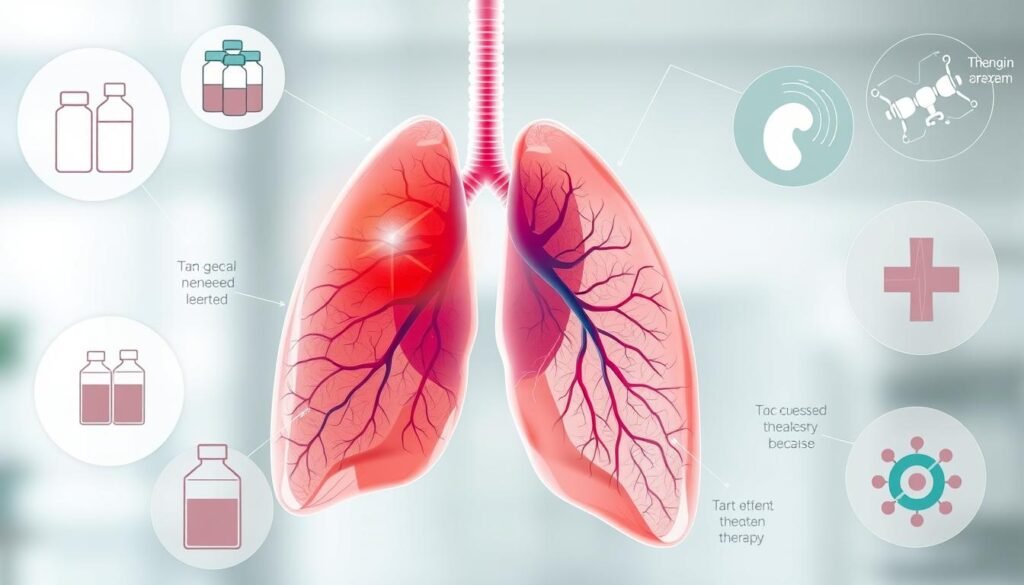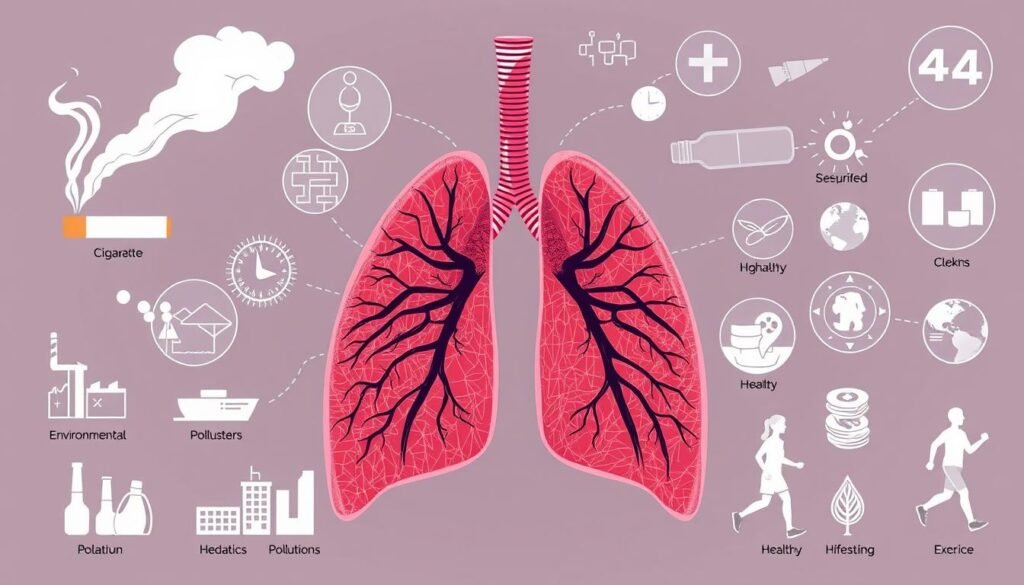About 15-20% of lung cancers are small cell lung cancer (SCLC). It’s known for being aggressive and spreading quickly. This is different from non-small cell lung cancer (NSCLC), which makes up about 80-85% of lung cancer cases. Knowing the differences between SCLC and NSCLC is vital for treatment and management. The growth rates and behavior differ greatly, impacting patient outcomes greatly.
We’ll explore SCLC and NSCLC in this article, looking at their traits, symptoms, treatment options, and survival rates. Understanding these types and their differences helps with diagnosis and treatment paths.
Key Takeaways
- Small cell lung cancer accounts for about 15-20% of lung cancer cases.
- Non-small cell lung cancer is more prevalent, comprising approximately 80-85% of diagnoses.
- SCLC is characterized by rapid growth and a worse prognosis compared to NSCLC.
- Effective management of lung cancer relies on understanding the differences between SCLC and NSCLC.
- Patients at high risk for lung cancer should consider screening for early detection.
Understanding Lung Cancer Types
Lung cancer starts in the cells lining the lungs. It has two main types: small cell lung cancer and non-small cell lung cancer. These types differ in how they look, grow, and how they are treated.
Small cell lung cancer (SCLC) is less common. It makes up about 10% to 15% of cases. SCLC grows and spreads fast, often moving beyond the lungs quickly. Smoking greatly increases the risk, so catching it early is key.
Non-small cell lung cancer (NSCLC) is more common, making up 80% to 85% of cases. Adenocarcinoma is the most common type among NSCLC, especially in non-smokers. Squamous cell carcinoma, linked to smoking, usually starts in the middle of the lungs. Large cell carcinoma, another NSCLC type, also grows fast and can spread quickly, making treatment challenging.
Knowing the differences between these cancer types helps patients and doctors talk better. For more information, check out this resource on lung cancer types.
Overview of Small Cell Lung Cancer
Small cell lung cancer (SCLC) makes up 15 to 20% of lung cancer cases. It is known as an aggressive lung cancer because it grows quickly. It also spreads early to important organs like the brain, liver, and bones. SCLC usually starts in the bronchi. Most people find out they have it when it’s already advanced. This makes small cell lung cancer overview worrying since finding it early is hard.
SCLC has two main types: small cell carcinoma and combined small cell carcinoma. The second type has both small cell and non-small cell traits. The main SCLC characteristics include a strong link with cigarette smoking. This sets it apart from other lung cancers. Being around radon and asbestos can also increase the risk of getting this cancer.
About 1 in 3 people get diagnosed with limited-stage SCLC. Meanwhile, extensive-stage SCLC occurs in about 2 in 3 patients. The fast growth of SCLC highlights the need for quick treatment. Doctors often use drugs like carboplatin, cisplatin, cyclophosphamide, and docetaxel. These are picked to fight the quickly spreading disease.
Characteristics of Non-Small Cell Lung Cancer
Non-small cell lung cancer (NSCLC) makes up most lung cancer cases, about 85%. It’s usually less aggressive than small cell lung cancer. Knowing its characteristics helps in its diagnosis and treatment.
NSCLC includes several types, like adenocarcinoma, squamous cell carcinoma, and large-cell carcinoma. Adenocarcinoma is the most common, making up 40% of NSCLC cases. Squamous cell carcinoma is about 30%, and large-cell carcinoma is 10-15%. Each one starts in different lung areas and acts differently.
Finding NSCLC early greatly increases treatment success. The 5-year survival rate ranges from 64% in early stages to 8% in advanced stages. Sadly, only 25% of patients find out they have it in stages 1 or 2. This shows the need for more awareness of risk factors and symptoms.
- Persistent cough
- Chest pain
- Difficulty breathing or wheezing
- Blood in sputum
- Hoarseness
- Weight loss and fatigue
- Swelling in the face or neck veins
Doctors use tests like chest x-rays, CT scans, and biopsies for diagnosing NSCLC. Knowing the different NSCLC types helps in managing and treating it.
| Type of NSCLC | Percentage of Cases |
|---|---|
| Adenocarcinoma | 40% |
| Squamous Cell Carcinoma | 30% |
| Large-Cell Carcinoma | 10-15% |
Overall, understanding NSCLC types and characteristics is key to better patient care. It leads to improved detection and treatment choices.
How Small Cell Lung Cancer Differs from Non-Small Cell Lung Cancer
SCLC and NSCLC show big differences, especially in their cells and how fast they grow. Knowing these differences helps doctors diagnose and plan treatment correctly.
Differences in Cell Structure
Small Cell Lung Cancer (SCLC) has small, round cells. Non-Small Cell Lung Cancer (NSCLC) has bigger cells in many shapes and sizes. These differences in cells are key for telling the two cancers apart. SCLC’s cell structure makes it spread faster and become more serious quickly.
Rate of Growth and Spread
SCLC grows fast, doubling in size in just weeks. This leads to quick symptom development. In contrast, NSCLC grows slower. This speed difference means SCLC patients see symptoms sooner, making treatment more complex. SCLC also spreads to other body parts like lymph nodes and the brain more often, which makes treating it harder.

| Feature | SCLC | NSCLC |
|---|---|---|
| Cell Structure | Smaller, rounded cells | Larger, varied shapes |
| Growth Rate | Rapid, typically doubles in weeks | Slower, often diagnosed at advanced stages |
| Metastasis | High likelihood to spread | Less aggressive spread |
| Prevalence | 10-15% of cases | 85% of cases |
Common Symptoms of Both Types
It’s vital to catch early signs of lung cancer quickly. This can mean a better chance at fighting it. People might notice different symptoms, which can happen with small cell lung cancer (SCLC) and non-small cell lung cancer (NSCLC). The symptoms might show up in different ways depending on the cancer type.
General Symptoms
Some common signs of lung cancer are:
- Persistent cough
- Coughing up blood
- Chest pain
- Shortness of breath
- Unexplained weight loss
- Fatigue
- Wheezing
- Loss of appetite
These symptoms can be clues for either SCLC or NSCLC. But they don’t always show up at the same point in the illness. Finding these signs early is key to better outcomes. It’s especially critical for smokers to watch out for these and talk to a doctor if they show up. You can learn more about these warning signs in this resource.
Symptoms Unique to Each Type
SCLC often brings different signs than NSCLC because it tends to spread quickly. Some SCLC specific symptoms are:
- Bone pain
- Neurological complications
- Facial swelling (often related to superior vena cava syndrome)
NSCLC, on the other hand, might cause problems that depend on the tumor’s location in the lungs. These symptoms include:
- Recurrent infections
- Unusual syndromes often associated with specific tumor locations
- Symptoms related to paraneoplastic syndromes
Knowing the difference between SCLC and NSCLC signs is critical. It helps doctors find the right treatment. Both types are serious and need quick action. Spotting these signs early may help greatly in managing the illness.
Cancer Staging in SCLC vs. NSCLC
Cancer staging is key in deciding treatment and guessing outcomes. For Small Cell Lung Cancer (SCLC), one in three people will have cancer in just one lung. The other two-thirds find the cancer has spread beyond their lungs.
The TNM system is used for NSCLC staging. It looks at tumor size, lymph nodes, and spread. Lung cancer stages with TNM range from 0 to IV. Stage 0 is when cancer hasn’t spread, and stage IV means it’s in distant organs.
Unlike NSCLC, SCLC is seen as limited or extensive. Yet, there’s a move towards using numbers like in NSCLC. Clinical staging uses tests like imaging and biopsies before treatment. Surgical staging, done during surgery, tells us how far cancer has spread.
- SCLC Staging: Limited and extensive classifications
- NSCLC Staging: Follows the TNM system with stages I-IV
- Key TNM Components: Tumor size (T), node involvement (N), and metastasis (M)
Getting cancer staging right is crucial for SCLC and NSCLC treatments. Knowing the differences in staging between the two helps in picking the best treatment. This leads to better patient results.
Treatment Options for Small Cell Lung Cancer
Treatment for small cell lung cancer (SCLC) focuses on effective strategies to fight this tough disease. SCLC treatment mainly uses a mix of therapies. The key ones are chemotherapy and radiation.
Chemotherapy as Primary Treatment
Chemotherapy is a main treatment for SCLC. It targets the rapid growth of cancer cells and eases symptoms. For limited-stage SCLC, treatment usually includes etoposide with cisplatin or carboplatin. Often, this comes with radiation therapy to the chest.
This approach aims to improve survival rates and the chance of a cure. Even though there are side effects, having both treatments together is good for patients.
Role of Radiation Therapy
Radiation therapy has two big roles in treating SCLC. First, it helps prevent brain metastasis, which is common in SCLC. Second, it’s used in palliative care to help those with advanced disease feel better.
Prophylactic cranial radiation is effective in reducing the risk of cancer coming back in the brain. It gives some patients a better chance at living longer. As we see more use of chemotherapy with immunotherapy, research continues to find new treatments for SCLC patients.
Treatment Strategies for Non-Small Cell Lung Cancer
Non-small cell lung cancer (NSCLC) has various treatment options, which depend on the patient’s diagnosis and cancer stage. Knowing these treatments helps meet patient needs and offers hope for better outcomes.
Surgical Interventions
Surgery is a main treatment for early-stage NSCLC. Operations like lobectomy or pneumonectomy remove part or all of a lung. These methods can help patients recover and live longer. Finding cancer early is key, making these surgeries more successful.
Use of Targeted Therapies
Targeted therapies are chosen for tumors with specific genetic markers. They aim to change how cancer cells grow and spread. These treatments can be more precise than chemotherapy, with less side effects. It’s important to talk with a doctor about these options to improve NSCLC treatment outcomes.

Prognosis and Survival Rates
The outlook for lung cancer varies a lot between small cell and non-small cell types. Knowing these differences is key for patients and families. It helps in making treatment choices and setting expectations.
Outlook for Small Cell Lung Cancer Patients
Small cell lung cancer (SCLC) survival rates are low due to its aggressive nature. Patients with early SCLC have a 30% chance of living five years. As the cancer grows, survival rates fall to 18% for regional stages and just 3% for distant ones. The average survival rate for all stages is only 7%. The risk of cancer coming back is high, highlighting the need for constant care and tailored treatment plans. For more on treating this cancer, check this guide.
Prognosis for Patients with Non-Small Cell Lung Cancer
On the other hand, non-small cell lung cancer (NSCLC) has a better outlook, especially when caught early. About 65% of localized NSCLC patients survive for five years. This drops to 37% for those with regional cancer spread. And it falls to 9% when the cancer has spread far. Still, the combined five-year survival is about 28%. Treatment advances are improving these numbers. New therapies and targeted treatments are making a big difference for patients.
| Type of Lung Cancer | Localized | Regional | Distant | All Stages Combined |
|---|---|---|---|---|
| Survival Rates for SCLC | 30% | 18% | 3% | 7% |
| Survival Rates for NSCLC | 65% | 37% | 9% | 28% |
Risk Factors for Lung Cancer
Knowing the risk factors for lung cancer helps us understand the disease. It’s important to see the differences in risks for Small Cell Lung Cancer (SCLC) and Non-Small Cell Lung Cancer (NSCLC). Smoking is the top risk for both types, greatly affecting health.
Common Risk Factors for SCLC
Smoking is the main risk for SCLC, causing most cases. Key factors include:
- Smoking: It’s linked to about 80% of lung cancer deaths.
- Secondhand Smoke: It’s the third leading cause of lung cancer in the U.S.
- Radiation Exposure: Chest radiation therapy raises risk levels.
- Genetic Predispositions: Family history can make you more vulnerable.
Risk Factors Associated with NSCLC
NSCLC shares some SCLC risks but has others too. These include:
- Occupational Exposures: Asbestos or radon exposure at work, especially with smoking, is risky.
- Environmental Toxins: Pollution, like diesel fumes, is partly to blame for lung cancer.
- Family History: If lung cancer runs in your family, NSCLC risk increases.
- Other Smoking Products: Using marijuana and e-cigarettes might also raise your risk.

It’s crucial to know these risks for prevention and early detection. Understanding SCLC and NSCLC risks helps us make better health decisions.
Conclusion
Knowing the different types of lung cancer is key. Small cell lung cancer (SCLC) and non-small cell lung cancer (NSCLC) are not the same. SCLC makes up about 20% of lung cancers, while NSCLC is more common at 80%. Understanding symptoms, risk factors, and treatments helps with early diagnosis and better results.
Studies highlight big risks for lung cancer patients getting brain metastases, with up to 65% affected. New diagnostic tools, like multiparametric MRI, allow doctors to accurately identify cancer types. This helps them create more effective treatment plans for both SCLC and NSCLC.
With ongoing research and learning, treatment options keep getting better, even for the challenging SCLC. Doctors and scientists are working hard to find new ways to fight lung cancer. Raising awareness about lung cancer is crucial for improving patient care. For deep insights on SCLC and its treatments, check out this research study.